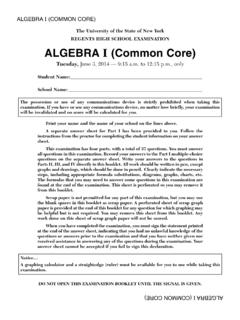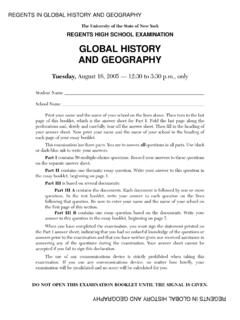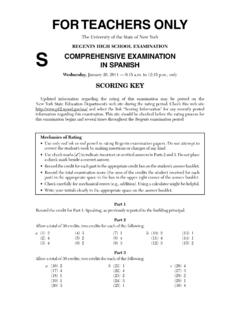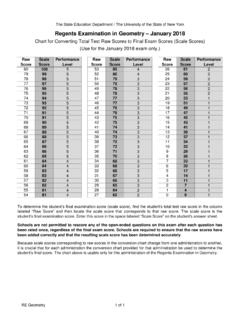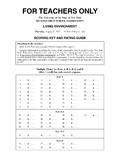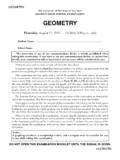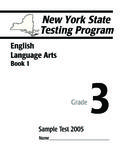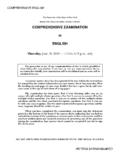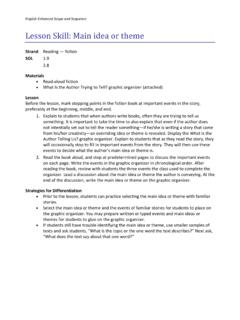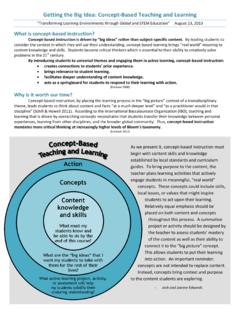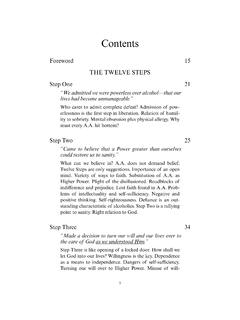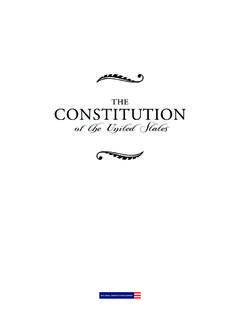Transcription of 1 Responses at this Level - Regents Examinations
1 Regents Exam in ELA (Common Core) Rating Guide June 17 [53] THE STATE EDUCATION DEPARTMENT / THE UNIVERSITY OF THE STATE OF NEW YORK / ALBANY, NY 12234 New York State Regents examination in English Language Arts (Common Core) Part 3 Rubric Text Analysis: Exposition Criteria 4 Responses at this Level : 3 Responses at this Level : 2 Responses at this Level : 1 Responses at this Level :Content and Analysis: the extent to which the response conveys complex ideas and information clearly and accurately in order to respond to the task andsupport an analysis of thetext -introduce a well-reasoned central idea and a writing strategy that clearlyestablish the criteria for analysis-demonstrate a thoughtful analysis of the author s use of the writing strategy to develop the central idea -introduce a clear central idea and a writing strategy that establish the criteria for analysis -demonstrate an appropriate analysis of the author s use of the writing strategy to develop the central idea -introduce a central idea and/or a writing strategy-demonstrate a superficial analysis of the author s use of the writing strategy to develop the central idea -introduce a confused or incomplete central
2 Idea or writing strategy and/or-demonstrate a minimal analysis of the author s use of the writing strategy to develop the central idea Command of Evidence: theextent to which the response presents evidence from the provided text to support analysis -present ideas clearly and consistently, making effective use of specific and relevant evidence to support analysis -present ideas sufficiently, making adequate use of relevant evidence tosupport analysis -present ideas inconsistently, inadequately, and/or inaccurately in an attempt to support analysis, making use of some evidence that may be irrelevant -present little or no evidence from the text Coherence, Organization, and Style: the extent to which the response logically organizes complex ideas , concepts, and information using formal style and precise language -exhibit logical organization of ideas andinformation to create a cohesive and coherent response -establish and maintain a formal style, using precise language and sound structure -exhibit acceptable organization of ideas and information to create a coherent response -establish and maintain a formal style, using appropriate language and structure -exhibit inconsistent organization of ideas and information, failing to create a coherent response -lack a formal style, using language that is basic, inappropriate, or imprecise -exhibit little organization of ideas and information -use language that is predominantlyincoherent, inappropriate.
3 Or copieddirectly from the task or text -are minimal, making assessment unreliable Control of Conventions: the extent to which theresponse demonstrates command of conventions of standard English grammar, usage, capitalization, punctuation, and spelling -demonstrate control of the conventions with infrequent errors -demonstrate partial control of conventions with occasional errors that do not hinder comprehension -demonstrate emerging control ofconventions with some errors that hinder comprehension -demonstrate a lack of control ofconventions with frequent errors thatmake comprehension difficult-are minimal, making assessment of conventions unreliable A response that is a personal response and makes little or no reference to the task or text can be scored no higher than a 1.
4 A response that is totally copied from the text with no original writing must be given a 0. A response that is totally unrelated to the task, illegible, incoherent, blank, or unrecognizable as English must be scored as a 0. Anchor Paper Part 3 Level 4 A Regents Exam in ELA (Common Core) Rating Guide June 17 [54] Anchor Level 4 A The response introduces a well-reasoned central idea [The explorer conveys that the destruction of the Endurance (the ship that was more than just his floating home ) was heartbreaking] and a writing strategy (The explorer extensively develops his main theme through the use of figurative language, primarily Personification) that clearly establish the criteria for analysis.
5 The response demonstrates a thoughtful analysis of the author s use of figurative language to develop the central idea (This personification shows how the explorer feels the pain of his ship dying and This goes to show that at the moment at which his ship was destroyed, it was as if a loved one was being gunned down). The response presents ideas clearly and consistently, making effective use of specific and relevant evidence to support analysis (The explorer states that it was in the ship that he had centered ambitions, hopes, and desires and the explorer personifies the cause of destruction: the floes. He refers to the event as the attack of the ice ). The response exhibits logical organization of ideas and information to create a cohesive and coherent response by first introducing a central idea that focuses on how the explorer was greatly disturbed by the tragedy and then presenting a writing strategy and demonstrating how the use of figurative language successfully reached the audience and conveyed his feelings.
6 The response establishes and maintains a formal style, using precise language and sound structure (The explorer gives the ship human qualities to illustrate the importance of the Endurance in his life and heart and The explorer also refers to the ship as her or she ). The response demonstrates control of conventions with infrequent errors (primarily Personification). Regents Exam in ELA (Common Core) Rating Guide June 17 [55] Anchor Paper Part 3 Level 4 B Regents Exam in ELA (Common Core) Rating Guide June 17 [56] Anchor Paper Part 3 Level 4 B Regents Exam in ELA (Common Core) Rating Guide June 17 [57] Regents Exam in ELA (Common Core) Rating Guide June 17 [58] Anchor Paper Part 3 Level 4 B Anchor Level 4 B The response introduces a well-reasoned central idea (He details their current predicament and records the circumstances that had led up to their detrimental situation.)
7 However, throughout the entire piece, there is that lingering hope and perseverance to trudge forward) and a writing strategy (Through strong diction, the explorer conveys that underlying sense of hope in his journal to maybe make it home alive with his crew and expresses that if they don t, they at least tried) that clearly establish the criteria for analysis. The response demonstrates a thoughtful analysis of the author s use of diction to develop the central idea (he utilizes diction that personifies their ship. By using phrases such as straining and groaning and her wounds gaping, the author highlights the end of their ship as a death and Although the challenges that await them will test their strength, they will venture forward). The response presents ideas clearly and consistently, making effective use of specific and relevant evidence to support analysis (the explorer augments his explanation of the disaster by stating, I cannot describe the impression of the relentless destruction that was forced upon me and He utilizes phrases such as long and strenous to describe the current journey ahead.
8 He states that the journey they are about to embarck on is going to be exceptionally difficult yet they are still going to try their absolute hardest to make it to safety with no lives lost). The response exhibits logical organization of ideas and information to create a cohesive and coherent response , first introducing and explaining a central idea and writing strategy, then discussing how the explorer utilizes descriptive diction to establish the severity of their predicament and his perseverance to trudge on even though the odds are against them, and concluding with a summative paragraph (That unwavering hope for the future is one of humankinds greatest assets that aids us through the darkest of times as it did for the South Pole explorer). The response establishes and maintains a formal style, using precise language and sound structure (He details their current predicament and records the circumstances that had led up to their detrimental situation) The response demonstrates partial control of conventions with occasional errors (one.
9 They, him and his crew, strenous, embarck, probility, humankinds) that do not hinder comprehension. Anchor Paper Part 3 Level 3 A Regents Exam in ELA (Common Core) Rating Guide June 17 [59] Anchor Level 3 A The response introduces a well-reasoned central idea and a writing strategy that clearly establish the criteria for analysis (The language used helps convey a dismal yet hopeful tone in this piece which greatly helps to develop the central idea of perserverance even through the worst conditions). The response demonstrates a thoughtful analysis of the author s use of tone to develop the central idea (The language used in this excerpt creates a dismal tone with the destruction of the ship but then shifts towards a more hopeful tone when disscussing the future.
10 These tones help the reader to identify the central theme of perserverance even in the worst of times). The response presents ideas sufficiently, making adequate use of relevant evidence to support analysis (the description of the ship breaking in the ice uses language such as sickening sensation , relentless destruction and annihilating which paints a dismal picture and conveys a dismal tone and the tone later in the piece, turns hopeful .. with language such as good morale , trust and safety ). The response exhibits acceptable organization of ideas and information to create a coherent response , first identifying the writing strategy and the central idea, then addressing the dismal tone and then changing to one of hope when the author is dicussing the future, and concluding with a recognition of the author s concern for the safety of his crew and a reiteration of the writing strategy and central theme.

